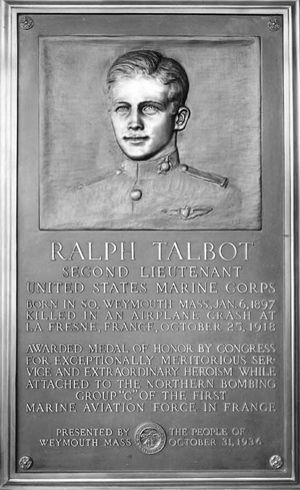
Naval History & Heritage Command photo 19-N-17912.
2d Lt Ralph Talbot.
In June 1917, Ralph Talbot left Yale University to join the DuPont Aviation School in Wilmington, Delaware. In November he entered federal service in Boston. He took his ground school training at the Massachusetts Institute of Technology and was then sent to Key West, Florida. There he was commissioned an ensign in the U.S. Naval Flying Corps, on 8 April 1918. In Miami, Florida, he was transferred to the United States Marine Corps Reserve Flying Corps and commissioned a second lieutenant on 26 May 1918, and in mid-July was sent overseas with the 1st Marine Corps Aviation Force.
With some other American pilots, Lt. Talbot was sent to a British school, called the “Pilots’ Pool.” When he finished his course, the first of his squadron, he was given its only De Haviland 4 with Liberty motor, to operate with the British. They were at that time engaged in dropping “bully beef” to a detachment of French troops cut off from their supply base. Lt. Talbot used to laugh about his “aerial grocery business,” but one of his comrades described its dangers: “the tins were dropped from under five hundred feet, and the ships were exposed to a terrific machine gun and rifle fire.” Later he went high-bombing with the British, bombing Ostend and Bruges from 12,000 feet. His machine was so fast that he was given the difficult task of protecting the rear of the squadron. On one of his earliest raids, while the squadron was engaged in a running fight with a superior number of Germans, he brought down the Boche plane for which he was given official credit.
In the early afternoon of 25 October 1918, Lt. Talbot of the 3d Squadron, Marine Corps Air Service, set out from a post near the Belgian front to make a short motor test. There was engine trouble; the machine failed on the takeoff, crashed into a high embankment and instantly burst into flames. All efforts to extricate the pilot were in vain. Death must have been instantaneous. He was buried in the Les Barracques military cemetery in the town of Sangatte, near Calais. He had been officially credited with downing one enemy plane and cited for bravery. After his death the Medal of Honor was awarded to him by the Navy Department with the following citation:
Sources: USMC History Division; USMC Medal of Honor Awardees